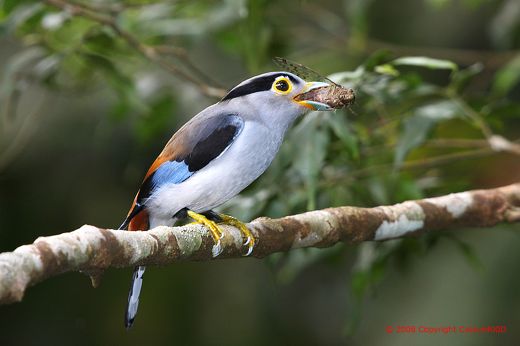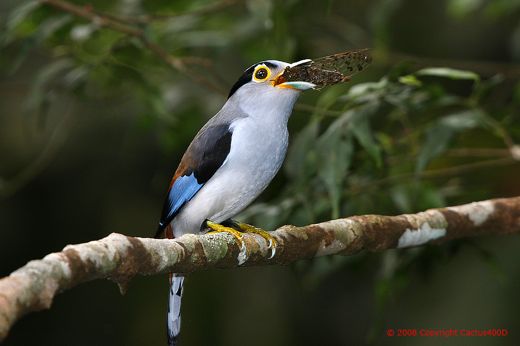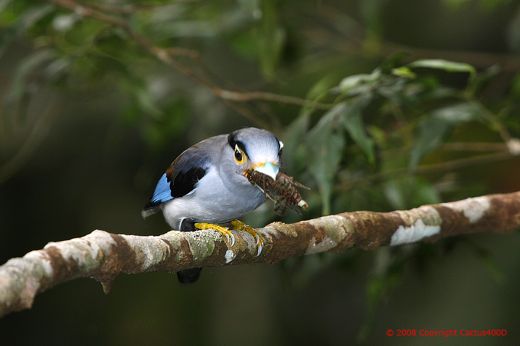In March 2008, Roger Moo a.k.a. cactus400D documented a Silver-breasted Broadbill (Serilophus lunatus) in Malaysia catching a cicada and swallowing it.
The photographers were just assembling when the broadbill suddenly flew in and perched on a branch of a nearby tree. It had a cicada in its bill (above). This naturally provided an excellent photo opportunity. The bird kept on “…jerking, shaking vigorously, swinging its head from one side to the other, trying hard to kill it… almost choking itself trying to swallow a meal too big for it…”
The broadbill repositioned the cicada such that the head was directed towards the oral cavity and tried hard to swallow it (above, below). This is very unlike what the Tiger Shrike (Lanius tigrinus) does, tearing the cicada into pieces and swallowing the pieces separately. Another earlier post showed a Black-naped Oriole (Oriolus chinensis) manipulating a cicada.
There are seven species of broadbill in the Thai-Malay Peninsula but details on food and foraging are limited. These birds take mostly arthropods, including insects like grasshoppers, flying termites, moths, butterflies and stick insects. Instances of taking lizards, molluscs, crabs, fish and fruits have also been reported.
In the case of the Silver-breasted Broadbill, Wells (2007) reports no direct information from reviews on foraging. There is definitely no mention of cicadas and this would be a new food record for this species. However, cicadas as food has been reported for Long-tailed Broadbill (Psarisomus dalhousiae) by Bruce (2003).
Referring to a recently published reference on cicadas in Thailand (Boulard, 2007), it is tempting to ID the genus as Megapomponia. However, our entomology advisor Prof Cheong Loong Fah has this to say: “…cicada species all look quite alike, depending on subtle characters for id (even to genera level).” So we shall leave it at that unless someone volunteers with an ID.
Reference:
1. Boulard, M. (2007). The cicadas of Thailand. General and particular characteristics. Vol. 1. Bangkok: White Lotus Co.
2. Bruce, M. D. (2003). Family Eurylaimidae (broadbills). Pp.54-93 in: del Hoyo, J., Elliott, A. & Christie, D. A. eds. Handbook of the birds of the world. Vol. 8. Broadbills to Tapaculos. Barcelona: Lynx Editions.
3. Wells, D.R. (2007). The birds of the Thai-Malay Peninsular. Vol. II, Passerines. Christopher Helm, London.
All images by Roger Moo.
This post is a cooperative effort between www.naturepixels.org and BESG to bring the study of bird behaviour through photography to a wider audience.











